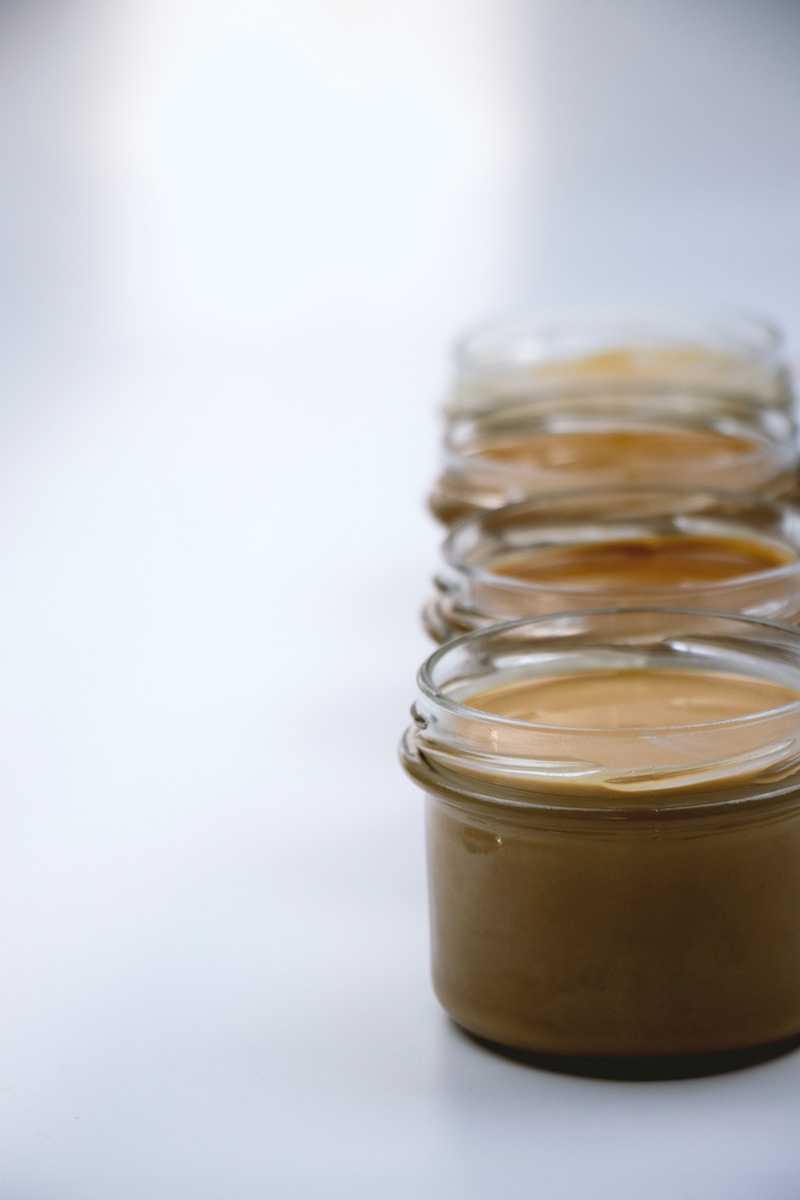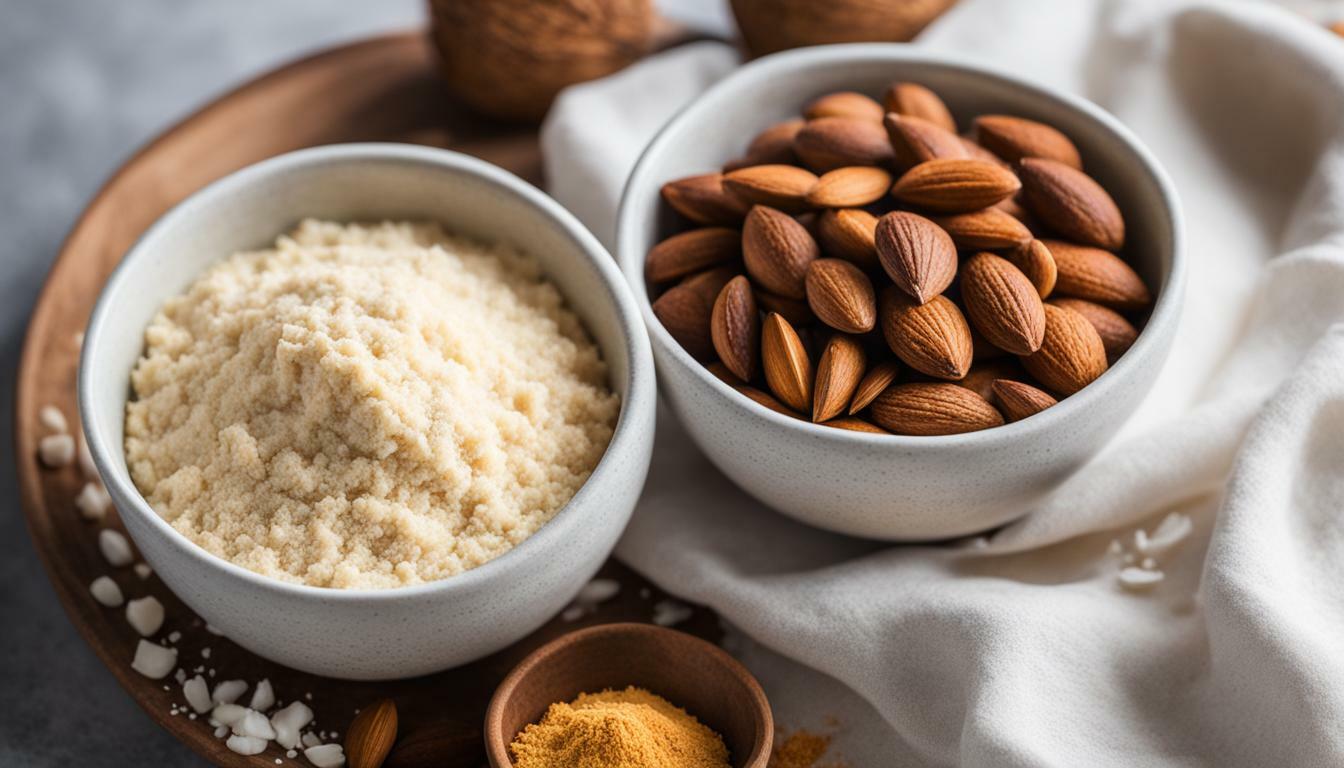Peanut butter and almond butter are two popular spreads that have been consumed for decades. While they have similarities, such as being a good source of protein and healthy fats, they also have differences in their nutritional content, taste, and overall health benefits. In this article, we will explore the key differences between peanut butter and almond butter, helping you make an informed choice when it comes to adding them to your diet.
Key Takeaways:
- Peanut butter and almond butter are both nutritious spreads that offer protein and healthy fats.
- Almond butter tends to have more vitamins, minerals, and fiber compared to peanut butter.
- Peanut butter has a rich and creamy taste, while almond butter has a slightly sweeter and nuttier taste.
- Peanut butter is more widely available and less expensive than almond butter.
- Individuals with peanut allergies should avoid peanut butter, while those with almond allergies should avoid almond butter.
- Both spreads can be used in a variety of ways and offer culinary versatility.
- The choice between peanut butter and almond butter comes down to personal preference, dietary needs, and budget.
Nutritional Comparison: Peanut Butter vs Almond Butter
When comparing the nutritional content of peanut butter and almond butter, both spreads offer a rich array of macronutrients and health benefits. However, there are some key differences to consider.
Calories and Macronutrients: Both peanut butter and almond butter are calorie-dense spreads, but almond butter tends to have slightly fewer calories. A 2-tablespoon serving of peanut butter contains around 188 calories, while the same serving size of almond butter contains about 180 calories. In terms of macronutrients, both spreads are excellent sources of protein and healthy fats. Peanut butter typically offers slightly more protein, while almond butter usually has more monounsaturated fat, which is known for its heart-healthy benefits.
Vitamins, Minerals, and Fiber: Almond butter has the advantage when it comes to vitamins, minerals, and fiber. It tends to contain higher levels of vitamin E, magnesium, and calcium compared to peanut butter. Additionally, almond butter is a good source of dietary fiber, which aids in digestion and helps maintain a healthy weight. Peanut butter, on the other hand, contains more folate and vitamin B3, also known as niacin.
Health Benefits: Both peanut butter and almond butter offer unique health benefits. Peanut butter is rich in antioxidants, such as resveratrol, which can help reduce the risk of heart disease. Almond butter, with its higher content of monounsaturated fat, may also contribute to heart health by lowering LDL cholesterol levels. Both spreads provide essential nutrients and can be part of a balanced diet.
| Peanut Butter | Almond Butter | |
|---|---|---|
| Calories (per 2 tablespoons) | 188 | 180 |
| Protein (grams) | 7 | 6 |
| Fat (grams) | 16 | 16 |
| Saturated Fat (grams) | 2.5 | 1 |
| Monounsaturated Fat (grams) | 8 | 9 |
| Vitamin E (milligrams) | 1.8 | 4.5 |
| Magnesium (milligrams) | 49 | 77 |
| Calcium (milligrams) | 15 | 64 |
| Dietary Fiber (grams) | 2 | 3 |
Flavor and Texture: Peanut Butter vs Almond Butter
When it comes to flavor and texture, peanut butter and almond butter have distinct differences. Peanut butter has a rich and creamy taste, with a slightly salty flavor. It also has a smooth and spreadable texture. On the other hand, almond butter has a slightly sweeter and nuttier taste, with a thicker and grittier texture. Some people prefer the smoothness of peanut butter, while others enjoy the unique texture of almond butter. It ultimately comes down to personal preference and the flavor profile you prefer.
While peanut butter is known for its classic taste and texture, almond butter offers a different sensory experience. The slightly sweet and nutty flavor of almond butter can add a unique twist to your favorite recipes. It pairs well with fruits like apples or bananas, and the thicker texture adds a satisfying crunch. Almond butter is also a popular choice for those with dietary restrictions, as it is naturally gluten-free and can be enjoyed by individuals avoiding grains or gluten.
If you’re looking for a spread that adds a savory, salty punch to your dishes, peanut butter is the way to go. Whether used in sandwiches, sauces, or savory baked goods, peanut butter’s distinct flavor shines through. Its smooth and spreadable texture makes it easy to incorporate into various recipes. From classic peanut butter and jelly sandwiches to homemade peanut sauce for stir-fries, peanut butter adds a rich and indulgent taste.
Taste comparison:
| Flavor | Texture |
|---|---|
| Rich and creamy | Smooth and spreadable |
| Slightly salty | – |
| Slightly sweeter and nuttier | Thicker and grittier |
Uses:
- Peanut butter: Classic taste, great for sandwiches, sauces, and savory dishes.
- Almond butter: Slightly sweet and nutty flavor, pairs well with fruits, and adds a unique twist to recipes.
When it comes to flavor and texture, peanut butter and almond butter offer different options to suit various taste preferences. Whether you prefer the rich and creamy taste of peanut butter or the slightly sweeter and nuttier flavor of almond butter, both spreads can be enjoyed in a variety of ways. Experiment with different recipes and find how each spread enhances your favorite dishes.
Price and Availability: Peanut Butter vs Almond Butter
Price and availability are important factors to consider when choosing between peanut butter and almond butter. Peanut butter is more widely available and tends to be less expensive compared to almond butter. This is primarily due to the higher cost of almonds and the more limited regions in which they can be grown. However, almond butter is becoming more popular and is now commonly found in grocery stores and online retailers. The price difference between the two spreads can vary depending on the brand and specific ingredients used. It’s important to consider your budget and accessibility when making a decision.
| Factors | Peanut Butter | Almond Butter |
|---|---|---|
| Availability | Widely available | Becoming more common |
| Price Range | Less expensive | Can be more expensive |
| Regional Production | Can be grown in various regions | Limited regions for almond production |
As shown in the table above, peanut butter offers greater availability and generally falls within a lower price range compared to almond butter. However, it’s worth mentioning that the price difference may vary depending on the brand and specific ingredients used. Additionally, the regional production of almonds contributes to their higher cost and more limited availability.
Despite the cost and availability differences, both peanut butter and almond butter can be enjoyed as part of a balanced diet. It’s important to consider your dietary preferences, nutritional needs, and personal budget when making a choice between the two spreads.
Allergies and Dietary Restrictions: Peanut Butter vs Almond Butter
Allergies and dietary restrictions are important factors to consider when choosing between peanut butter and almond butter. Peanut allergies are more common compared to almond allergies, so individuals with peanut allergies should avoid peanut butter. Almond allergies are less common but still exist, so those with almond allergies should avoid almond butter. It’s crucial to read labels and choose brands that are free from any potential allergens or cross-contamination.
For individuals without allergies, both peanut butter and almond butter can be enjoyed as part of a balanced diet. However, it’s worth noting that peanut butter may pose a higher risk for cross-contamination, especially in facilities that process other allergens. It’s important to be aware of this if you have severe allergies or if you share a home with someone who does.
When it comes to dietary restrictions, both peanut butter and almond butter can be suitable options depending on your specific needs and preferences. Peanut butter is higher in protein, making it a good choice for individuals looking to boost their protein intake. Almond butter, on the other hand, is lower in carbohydrates, making it a better option for those following a low-carb or keto diet.
Healthier Choice: Peanut Butter or Almond Butter?
Both peanut butter and almond butter offer various health benefits, and the choice between the two depends on individual needs and preferences. Peanut butter is higher in protein, vitamin E, and folate, while almond butter is higher in fiber, vitamin E, and magnesium. Additionally, almond butter contains more monounsaturated fats, which are beneficial for heart health.
To make a healthier choice between peanut butter and almond butter, it’s important to consider your overall dietary intake and balance. Both spreads can be part of a healthy diet when consumed in moderation. It is always recommended to consult with a healthcare professional or registered dietitian to determine the best option for your specific health goals and needs.
| Peanut Butter | Almond Butter | |
|---|---|---|
| Protein Content | 7g per 2 tablespoons | 7g per 2 tablespoons |
| Fiber Content | 2g per 2 tablespoons | 3g per 2 tablespoons |
| Vitamin E Content | 2.9mg per 2 tablespoons | 7mg per 2 tablespoons |
| Magnesium Content | 49mg per 2 tablespoons | 61mg per 2 tablespoons |
| Monounsaturated Fat Content | 7g per 2 tablespoons | 9g per 2 tablespoons |
Table: Nutritional Comparison of Peanut Butter and Almond Butter (per 2 tablespoons)
Versatility: Peanut Butter vs Almond Butter
Both peanut butter and almond butter are versatile spreads that can be used in a variety of ways. They offer unique flavors and textures that can enhance a wide range of dishes and snacks.
Peanut Butter
Peanut butter is well-known for its rich and creamy taste. It has a slightly salty flavor that pairs well with both sweet and savory ingredients. One of the most popular uses for peanut butter is as a spread on toast or sandwiches. It can also be used as a dip for fruits or vegetables, adding a depth of flavor to your snacks. In addition, peanut butter can be incorporated into cooking and baking recipes, such as satay sauce, peanut butter cookies, or even as an ingredient in smoothies or oatmeal.
Almond Butter
Almond butter has a slightly sweeter and nuttier taste compared to peanut butter. It offers a distinct flavor profile that can enhance both sweet and savory dishes. Almond butter is commonly used as a spread on toast or used as a topping for desserts like pancakes or waffles. It can also be added to smoothies or oatmeal for a boost of flavor and nutrition. Additionally, almond butter can be used in baking recipes, such as almond butter brownies or energy bars. Its thicker and grittier texture adds a unique element to the dishes it’s used in.
Both peanut butter and almond butter can be enjoyed in creative ways, depending on your personal taste preferences and culinary creativity. Whether you’re looking for a savory or sweet addition to your meals, both spreads offer versatility that can elevate the flavors of your favorite dishes.
| Peanut Butter | Almond Butter | |
|---|---|---|
| Spread on Toast or Sandwiches | ✓ | ✓ |
| Dip for Fruits or Vegetables | ✓ | ✓ |
| Ingredient in Cooking/Baking | ✓ | ✓ |
| Smoothie/Oatmeal Additive | ✓ | ✓ |
| Used in Savory Dishes | ✓ | |
| Used in Sweet Treats | ✓ |
As shown in the table, both peanut butter and almond butter can be used in similar ways, such as spreading on toast or sandwiches, using as a dip, or incorporating into cooking and baking. However, there are slight differences, with peanut butter being more commonly used in savory dishes and almond butter often enjoyed in sweet treats. The choice between the two spreads ultimately depends on your personal preferences and the specific flavors you desire in your meals or snacks.
Conclusion
After comparing the nutritional content, flavor and texture, price and availability, allergies and dietary restrictions, and versatility of peanut butter and almond butter, it’s clear that both spreads have their own unique advantages. Almond butter provides more vitamins, minerals, and fiber, making it a slightly healthier option. On the other hand, peanut butter offers more protein and is generally more affordable.
When choosing between peanut butter and almond butter, it ultimately comes down to personal preference, dietary needs, and budget. Consider your taste preferences, nutritional requirements, and any allergies or dietary restrictions you may have. Both spreads can be enjoyed in moderation as part of a balanced diet.
Whether you enjoy the rich and creamy taste of peanut butter or the slightly sweeter and nuttier taste of almond butter, incorporating either spread into your meals and snacks can provide a delicious source of protein and healthy fats. Experiment with different recipes and find creative ways to use peanut butter or almond butter in your favorite dishes. Remember to always read labels and choose brands that align with your dietary needs and preferences.
FAQ
What are the key differences between peanut butter and almond butter?
Peanut butter and almond butter differ in their nutritional content, taste, and overall health benefits.
Which one is healthier, peanut butter or almond butter?
Both spreads have their own unique health benefits. Almond butter tends to have more vitamins, minerals, and fiber, while peanut butter offers more protein.
What is the difference in flavor and texture between peanut butter and almond butter?
Peanut butter has a rich and creamy taste with a slightly salty flavor, while almond butter has a slightly sweeter and nuttier taste with a thicker and grittier texture.
Is there a price difference between peanut butter and almond butter?
Yes, peanut butter is generally less expensive compared to almond butter due to the higher cost of almonds and their more limited availability.
Can individuals with allergies or dietary restrictions consume peanut butter or almond butter?
Individuals with peanut allergies should avoid peanut butter, while those with almond allergies should avoid almond butter. It is important to read labels and choose brands that are free from any potential allergens or cross-contamination.
How can peanut butter and almond butter be used in cooking?
Both spreads can be spread on toast, used as a dip for fruits or vegetables, added to smoothies or oatmeal, or used as an ingredient in baking.
Which spread should I choose, peanut butter or almond butter?
The choice between peanut butter and almond butter depends on personal preference, dietary needs, and budget. Both spreads can be enjoyed in moderation as part of a balanced diet.
 Skip to main content
Skip to main content


